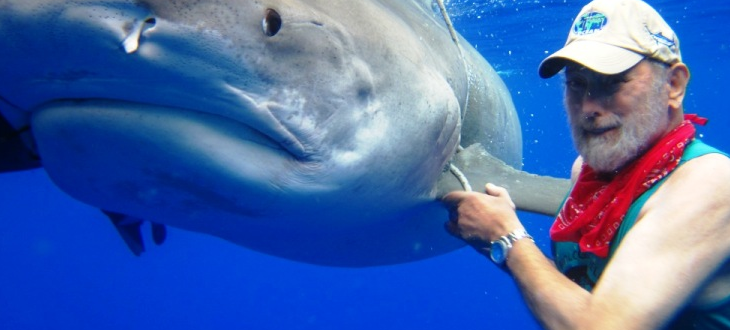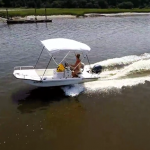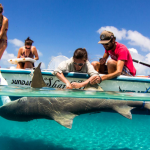An Interview with "Doc" Gruber of Bimini’s Shark Lab
South Bimini, Bahamas
To say Dr. Samuel H. Gruber (“Doc”) of the Bimini shark lab is a unique individual is an understatement. He’s a bit of a renaissance man, a pilot, former ballet dancer, and one of the world’s leading authorities on Lemon Sharks. While on his way to a class reunion at a Georgia military college, Doc Gruber stopped in for a tour of our facility. During the visit, we were able to chat about shark lab, life, and boats.

Dr. Samuel H. Gruber (“Doc”)
Composite Research: “First, just let me say thanks for stopping in and that we can’t stress enough that we love what you guys are doing. We are honored to partner with you and to lend a hand in the continued success of the shark lab. What many of our readers might not know is that the shark lab has a unique mission to study marine animals primarily sharks and rays, their environments and at the end of the day to influence policy makers towards conservation laws through education. One way we feel we can help is by raising awareness for your efforts. Ideally, from our blog we hope that our customers and those interested in our products can learn a bit about both our organizations. Now given you’re traveling and on a tight timeline, we’ll jump right in with the first question. So Doc, of all the hurdles what would you say are your biggest challenges with shark lab?”
Dr. Gruber: “Hurricanes and weather. After decades of renting we finally have our own facility. Our building is great but it needs to be lifted to avoid a potential storm surge. One big storm and we could be in big trouble. Over the years we’ve also seen sea levels rising due to global warming. In fact, the water lines are as much as four to six feet above where they were ten years ago.”
Composite Research: “What other daily challenges does the shark lab face?”
Dr. Gruber: “Logistics. Until recently we’d had reliable and reasonable deliveries for our supplies. We’ve seen rapid increases in duties, shipping and supply costs which are unexpected and always frustrating.”
Composite Research: “Those issues aside, what are the largest threats to the marine environment near shark lab?”
Dr. Gruber: “Commercial developers have found their way into the area. One of the largest casino developers in the world has started construction which includes lots of dredging and this just devastates the habitat. We estimate up to 40% of the mangroves around Bimini bay have been removed.”
Composite Research: “What’s the significance of a mangrove?”
Dr. Gruber: “The mangroves are the primary nursery for all types of marine animals. Without those, many of the animals there are in big trouble. The population decreases, less sharks, less of everything.”
Composite Research: “How does that (a smaller shark population) translate to humans? Specifically, how does that impact the common person?”
Dr. Gruber: “As I’ve always said, sharks are ‘the lords of time’; they’ve been here for half a billion years and have managed to survive incredible events. But an ocean without them is a sick ocean and for people who depend on the ocean, which we all do in some way, puts us in a terrible imbalance.”
Composite Research: “Our relationship is symbiotic. We sell fishing boats and in the case of a ‘sick ocean’ as you say, our business can’t survive if there are no fish to be caught. We definitely understand the importance of the balance. Funny, most people probably don’t realize that as a manufacturer we are first and foremost marine conservationist. So is there a singular species that you can say has been driven to, or close to extinction by over-fishing or other factors? Any specific examples you can provide?”
Dr. Gruber: “You’re exactly right. The relationships are certainly symbiotic and even though some marine resources are renewable to a certain degree, it takes hundreds if not thousands of years to replenish. As for an example of culling, the long liner Ocean White Tip shark is down to about 10% of its original population. It’s a significant predator and a big animal at fifty kilograms, they are coming back, slowly. But without a doubt, we (man) were the cause of the reduction in their population.”
Composite Research: “So commercial development or fishing, is one more damaging than the other?”
Dr. Gruber: “With the White Tip, its what’s known as cryptic mortality. We’ve used more than what can be replenished. But what’s encouraging is we are seeing efforts from historically over fished areas, even in countries like China, they now making changes to slow things down. As for development, it’s just devastating to the habitat with tons of the natural environment being removed.”
Composite Research: “Now changing topics on your a bit, you probably didn’t start out as a marine scientist, what other jobs have you had in the past?”
Dr. Gruber: “Let’s see, around 1952 I worked in a factory making roof trusses. I had another job where I was bending eye glass frames. A little later I followed a really pretty girl in to a dance studio and became ballet dancer.”
Composite Research: “Wow! A ballet dancer, that’s fantastic. How was that?”
Dr. Gruber: “I did a summer with the dance company, traveling. It was fun. But I had a lot going on and had plans to join the Air Force.”
Composite Research: “So what drove you to science?”
Dr. Gruber: “I had a conversation with my father and he said, ‘well planes get shot down and if you are going to be a dancer your career is over at thirty.’ So having that in my mind I was spear fishing and had a close encounter with a large hammer head and something about it just clicked. I knew that working with sharks was what I was going to do.”
Composite Research: “So what advice would you give young people looking to become scientists be it marine, or some other area? Specifically, where should they focus?”
Dr. Gruber: “Well years ago in order to do field study you had to actually go out into the field to do the work. Now with computers, a lot of the observations and measurements can be done from behind a desk. Given that, a focus on physics, computer science, or mathematics would be best.”
Composite Research: “On the topic of field research, how’s the fleet of Sundance boats holding up?”
Dr. Gruber: “They’re great boats. The crew loves them, we use them every day. The newest 22 footer is definitely the staff pick. No shortage of people volunteering for duty on that one.”
Composite Research: “How often are those boats in operation each day?”
Dr. Gruber: “It varies obviously but there are times were those boats are in use ten to twelve hours per day.”
Composite Research: “Any complaints?”
Dr. Gruber: “None. The boats are great, you guys are great. He’s (Wally Bell) is a genius about all of this stuff. He’s so full of knowledge and he’s managed to lead the company in the right direction to survive the economic crisis, he made it work. Just look around, boats are being built, people are working, you guys are doing great.”
Composite Research: “Thank you Doc. Is it safe to say we’ve come a long way since those first few skiffs?”
Dr. Gruber: “It (the company) sure has. Just looking around at everything going on here represents so many great accomplishments.”
Composite Research: “Well Dr. Gruber, we know you need to get on the road for your class reunion, thank you for your time and thanks for being such a strong and visible advocate for Sundance Boats.”
Dr. Gruber: “You are very welcome and thank you.”
About Shark Lab
Established & incorporated in 1990 by Dr. Samuel Gruber, today the Bimini Biological Field Station Foundation (BBFSF) is a 501 (c)(3) non-profit organisation located on the island of South Bimini, Bahamas. The mission of the BBFS Foundation is to advance our knowledge of the biology of marine animals especially the heavily impacted elasmobranch fish fauna (sharks and rays); to educate future scientists at undergraduate and graduate levels; and to disseminate our research results to advance the field of marine science and conservation biology, as well as raise public perception and awareness of sharks and other marine species.
For more information visit: http://www.biminisharklab.com/
Facebook: https://www.facebook.com/biminisharklab
Cover photo by CJ Crooks



